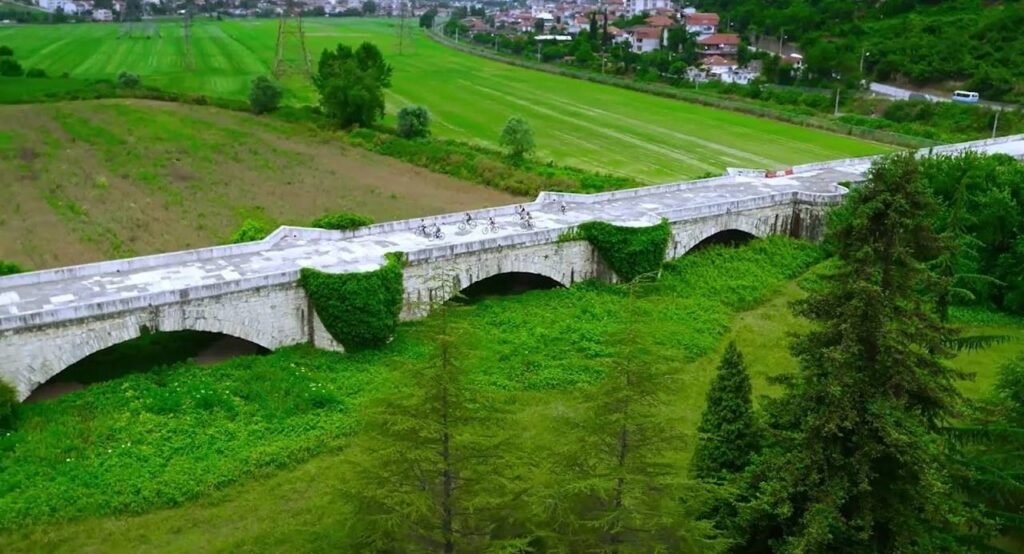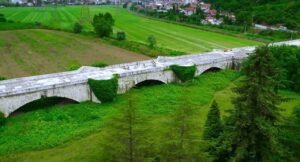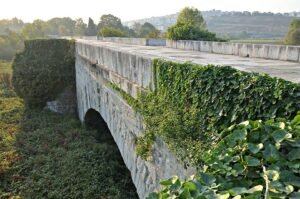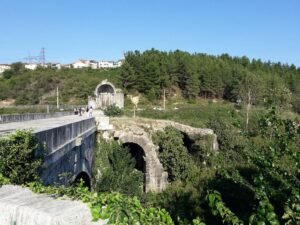Description
Justinianus Bridge, locally known as Beşköprü, is one of Anatolia’s most impressive early Byzantine monuments, hidden amidst the lush landscapes of Sakarya. This tourism article delves into its rich history, architectural marvels, cultural heritage, and tips for an unforgettable visit.
Historical Context
Built by Emperor Justinian I between 558–562 AD, the stone bridge was designed to support a critical military and trade route from Constantinople to the horizons of the empire. The structure replaced a fragile pontoon bridge prone to being swept away during seasonal floods, a perilous vulnerability noted by the historian Procopius .
Originally named Pons (“bridge” in Latin), its name evolved to Pontogephyra and eventually into the Turkish Beşköprü—“five bridges” or “five arches”—although this name is misleading given that the bridge features twelve arches, not five . A triumphal arch once stood at the western end, and an apsed pavilion stood at the eastern, adding grandeur and framing the crossing.
After centuries of service, tolls, and military use, it was closed to vehicle traffic in 1995, following restoration efforts by the General Directorate of Highways, transitioning it to pedestrian use.
Architectural Highlights
-
Length & Width: Approximately 365–430 m long and 9.85 m wide .
-
Arches: Hosts 12 arches — seven main semicircular arches (spanning 23–24.5 m) and five smaller flood arches (two west, three east).
-
Materials: Constructed from large limestone blocks—robust and enduring .
-
Cutwaters: Its piers have upstream cutwaters and downstream pointed exteriors—though some piers are wedge-shaped on both sides, a rare Roman design innovation.
-
Height: Rising up to 10 m above the stream bed .
-
Surrounding relics: Western end retains foundations of a triumphal arch; the eastern end holds remnants of an apsed vaulted structure .
Cultural & Heritage Significance
The historic bridge was added to Turkey’s archaeological inventory in 1982 and later designated a Grade I archaeological conservation site. In 2018, it was included in UNESCO’s Tentative World Heritage List, recognized for its structural integrity and authenticity .
UNESCO notes that despite minor repairs and partial demolition for railway works, the bridge’s original form, building materials, design, and construction technique remain remarkably intact . It has survived earthquakes—including the devastating Marmara quake—and harmful environmental factors, a testament to early Byzantine engineering resilience .
Additionally, ongoing restoration funded by Serdivan Municipality and the Highways Department aims to preserve the bridge for future generations. Work includes structural repairs, archaeological surveys, area illumination, visitor amenities, and landscaping . A significant 70 million TL (~US $3 million) was earmarked in 2024 for preliminary restoration, with the full project projected at 270 million TL .
Visiting Experience
Location & Access
-
Situated ~5–8 km southwest of Adapazarı city centre in Serdivan district, accessible via local buses and taxis .Located above the Çark Deresi (once Melas), which carries water from Sapanca Lake to Sakarya River.
-
It lies within a serene valley spot, ideal for strolling, photography, and scenic relaxation.
Best Time to Visit
-
Every season suits a leisurely walk. Spring to autumn brings vibrant greenery and comfortable weather; winter visits may uncover a snow-dusted panorama.
-
Visit early morning or late afternoon to enjoy soft lighting—perfect for photos and calmer ambiance.
Nearby Attractions
Pair your visit with these highlights:
-
Sapanca Lake: Just a short drive away for waterside walks or lakeside meals.
-
Sakarya Museum: Offers a broader understanding of the region's Roman, Byzantine, and Ottoman past.
-
Historic Mosques and Bazaars: Explore Orhan and Rüstem Paşa mosques, and the traditional 'Uzun Pazar' for immersive cultural experiences.
Facilities & Tips
-
Limited visitor facilities—pack essentials like water, snacks, and sun protection.
-
The bridge is pedestrian-only; wear comfortable shoes suitable for walking on uneven stone.
-
Respect preservation notices and avoid climbing on fragile structures.
-
Bring a camera—the sweeping arches, valley greenery, and changing light create stunning visual opportunities.
Suggested Itinerary
Half-Day Cultural Walk
-
Begin at Adapazarı center; take local transport to Beşköprü (~15 min ride).
-
Arrive mid-morning; walk across the historic bridge at your pace.
-
Pause at vantage points to photograph cutwaters and arches.
-
Explore the western triumphal arch remains and the eastern apsed structure.
-
Enjoy a picnic by the riverside or on the viaduct itself.
-
Return to town and visit Sakarya Museum, historic mosques, and bazaars.
-
Cap it off with lakeside refreshments in Sapanca.
Why This Site Matters
Justinianus Bridge is not just a relic; it is an embodied narrative of ingenuity and engineering from nearly 1,500 years ago. It showcases
-
Byzantine mastery: through its harmonious proportions, structural resilience, and architectural elegance.
-
Continuity of use: surviving wars, floods, and earthquakes and remaining part of local life.
-
Cultural echoes: visible in its changing name—from Latin Pons to Greek Pontogephyra, and the Turkish Beşköprü.
-
Future potential: as restoration continues, it stands to become a fully accessible heritage highlight, with interpretive panels and lighting enriching visitor experience.
Boosting Sakarya Tourism
Incorporating Beşköprü into broader tourism strategies could enhance Sakarya’s cultural offerings:
-
Heritage trail development: Connect the bridge with ancient mosque routes, markets, and museums.
-
Seasonal events: Host photo contests, historical reenactments, or art installations along the bridge and riverbank.
-
Education outreach: Coordinate with schools and universities for archaeological workshops and ongoing digs.
-
Ecotourism synergy: Leverage natural surroundings for guided hikes and eco-friendly tours.
-
UNESCO candidacy support: Finalizing restoration and presenting the bridge within a coherent conservation zone could strengthen its World Heritage bid.
Final Thoughts
More than stone and arches, Beşköprü stands as a monument to ancient foresight and continuity—its shadows carry the stories of emperors, pilgrims, soldiers, traders, and local communities across one and a half millennia. Now, completely pedestrian and once again in the spotlight, the bridge invites today’s travelers to tread its length and join in its story.
Whether you're a history admirer, architecture buff, photographer, or cultural traveler, Justinianus Bridge offers a unique blend of grandeur, tranquility, and historical resonance. Visit once—and you won’t easily forget the harmony between its arches and the landscapes they cross.
Location
-
Beşköprü, Justinianos Köprüsü, 54050 Serdivan/Sakarya



